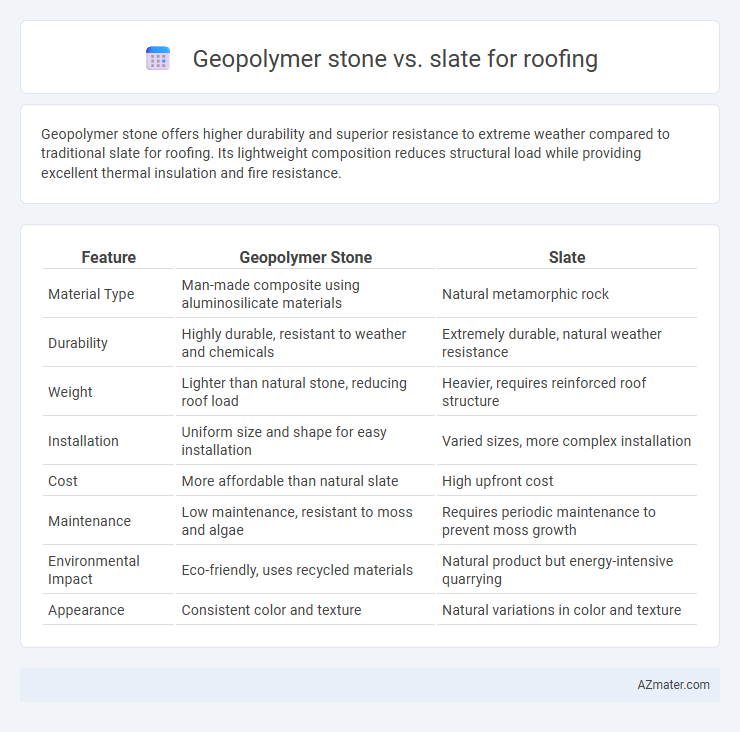Geopolymer stone offers higher durability and superior resistance to extreme weather compared to traditional slate for roofing. Its lightweight composition reduces structural load while providing excellent thermal insulation and fire resistance.
Table of Comparison
| Feature | Geopolymer Stone | Slate |
|---|---|---|
| Material Type | Man-made composite using aluminosilicate materials | Natural metamorphic rock |
| Durability | Highly durable, resistant to weather and chemicals | Extremely durable, natural weather resistance |
| Weight | Lighter than natural stone, reducing roof load | Heavier, requires reinforced roof structure |
| Installation | Uniform size and shape for easy installation | Varied sizes, more complex installation |
| Cost | More affordable than natural slate | High upfront cost |
| Maintenance | Low maintenance, resistant to moss and algae | Requires periodic maintenance to prevent moss growth |
| Environmental Impact | Eco-friendly, uses recycled materials | Natural product but energy-intensive quarrying |
| Appearance | Consistent color and texture | Natural variations in color and texture |
Introduction to Geopolymer Stone and Slate Roofing
Geopolymer stone roofing offers a sustainable, lightweight alternative to traditional slate, utilizing inorganic polymers synthesized from industrial byproducts such as fly ash and slag. Slate roofing, valued for its natural durability and aesthetic appeal, is a dense, metamorphic rock known for its long lifespan and resistance to weathering. Both materials provide excellent roofing solutions, with geopolymer stones emphasizing eco-friendliness and cost efficiency, while slate retains a classic, premium appearance with proven performance.
Material Composition and Formation
Geopolymer stone is synthesized from industrial byproducts like fly ash or slag combined with alkaline activators, resulting in a durable, chemically bonded material with high compressive strength and resistance to environmental degradation. Slate, a natural metamorphic rock formed from shale under high pressure and temperature, features a foliated structure that allows it to be split into thin, durable sheets ideal for roofing. The engineered composition of geopolymer stone offers consistent quality and eco-friendly attributes, whereas slate's natural formation provides unique textures and colors influenced by geological conditions.
Durability and Weather Resistance
Geopolymer stone roofing offers superior durability and weather resistance compared to traditional slate, as its synthetic composition provides enhanced resistance to cracking, fading, and moisture absorption. The dense, chemical-resistant structure of geopolymer stone withstands extreme temperature fluctuations, UV radiation, and heavy rain more effectively than slate, which can be prone to weather-induced wear over time. This makes geopolymer stone an increasingly preferred choice for roofing in climates with harsh environmental conditions, providing long-lasting protection and minimal maintenance.
Weight and Structural Impact
Geopolymer stone roofing tiles typically weigh less than natural slate, reducing the overall load on the building's structure and allowing for more flexibility in framing requirements. The lightweight nature of geopolymer stone lowers stress on roofs, minimizing potential structural reinforcement costs and improving seismic performance. Slate, being denser and heavier, demands stronger support systems, which can increase construction complexity and material expenses.
Aesthetic Appeal and Design Options
Geopolymer stone roofing offers a versatile aesthetic with customizable colors and textures that mimic natural materials, providing a modern yet natural look. Slate roofing boasts a timeless elegance with its unique, fine-grained texture and natural color variations, enhancing historical and classic architectural designs. The choice between geopolymer stone and slate depends on the desired blend of contemporary customization versus traditional authenticity in roofing design.
Environmental Sustainability
Geopolymer stone roofing offers significant environmental sustainability advantages over traditional slate by utilizing industrial byproducts such as fly ash and slag, reducing the need for quarrying natural stone and lowering carbon emissions associated with extraction and transport. Its production process consumes less energy and generates fewer pollutants, contributing to a smaller carbon footprint compared to slate roofing, which requires extensive mining and processing. Both materials are durable, but geopolymer stone's eco-friendly manufacturing and potential for recycling make it a more sustainable choice for green building projects.
Installation Process and Complexity
Geopolymer stone roofing offers a simplified installation process due to its uniform size and lightweight properties, reducing labor time and required support structures compared to traditional slate. Slate roofing demands skilled craftsmanship for precise cutting and fitting, as natural variations in stone thickness and weight increase complexity. The ease of handling geopolymer materials accelerates installation, making it a cost-effective alternative with less technical requirement.
Cost Comparison and Long-term Value
Geopolymer stone offers a cost-effective alternative to traditional slate roofing by providing lower upfront installation expenses due to its lighter weight and easier handling, which reduces labor costs. Over time, geopolymer roofing demonstrates superior durability and resistance to weathering, minimizing maintenance and replacement expenses compared to natural slate. Investing in geopolymer stone roofing results in enhanced long-term value through its balance of affordability, resilience, and lower lifecycle costs.
Maintenance Requirements
Geopolymer stone roofing requires minimal maintenance due to its high resistance to weathering, chemical corrosion, and UV radiation, ensuring long-lasting durability with infrequent inspections. Slate roofing, while known for its natural beauty and strength, demands more regular maintenance including checking for broken tiles, ensuring proper sealing, and preventing moss or algae growth to avoid water infiltration. Choosing geopolymer stone reduces lifecycle maintenance costs and labor compared to the specialized upkeep slate roofing necessitates.
Conclusion: Which Roofing Material is Best?
Geopolymer stone offers superior durability, low maintenance, and eco-friendly benefits compared to traditional slate roofing, which is heavier and more expensive but valued for its natural aesthetic and long history. In terms of cost-effectiveness and environmental impact, geopolymer stone is increasingly preferred for modern construction projects seeking sustainability and longevity. For those prioritizing timeless beauty and natural materials, slate remains a top choice, but for durability, affordability, and green building goals, geopolymer stone is the best roofing material.

Infographic: Geopolymer stone vs Slate for Roofing
 azmater.com
azmater.com